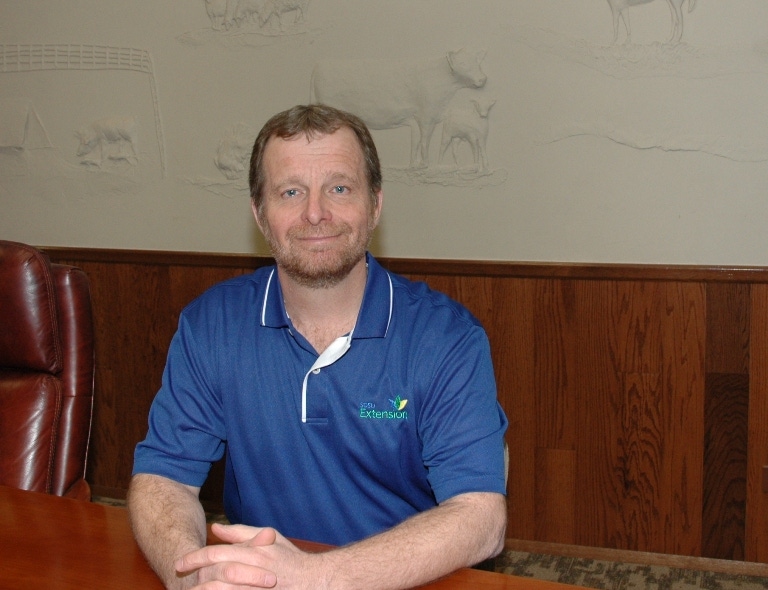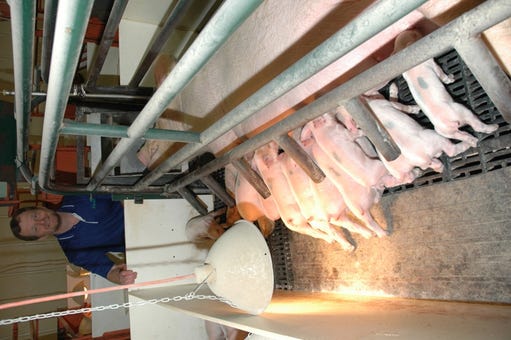2013 Master of the Pork Industry Robert Thaler
This humble leader has served the pork industry in many capacities during his 25-year tenure at South Dakota State University.

At a time when the pork industries in most states are striving for stability, South Dakota State University (SDSU) Extension swine specialist Bob Thaler finds his state’s industry in the midst of a growth spurt of sorts.
In December 2011, South Dakota reported a sow population of 169,000, which grew modestly to 175,000 sows by March 2013. Glenn Mueller, state executive for the South Dakota Pork Producers Council (SDPPC), estimates an additional 12,000 sows coming into production later this year, based on the number of new sow units approved and under construction, plus a couple of existing operations that are expanding. “We should have 187,000 sows in 2013, a 10.65% increase in sow numbers. If we get 25 pigs/sow/year (psy), we will have another 300,000 pigs farrowed in South Dakota,” Thaler says. The state ranks 11th in hog production, he adds.
A Good Place for Growth
That kind of growth in production was the result of a positive change in the environment at the county level. “It’s a positive development that was born in the early 1990s, when most states didn’t have regulations for manure management,” Thaler explains. “The SDPPC took the unusual step of asking the state to develop environmental regulations for pork producers, while other state commodity groups spurned the idea.” He served as an adviser in that effort.
“Livestock permitting in South Dakota used to be a real challenge, but it is getting better,” he says. “We have some counties that have very good zoning ordinances and follow them, and it goes fairly well. In other counties, it is not so good.
“The really ironic thing is one of the easiest counties to get livestock permits approved is in Minnehaha County where Sioux Falls (population 150,000) is located. They have a great model zoning ordinance, which says these are our rules, and if you follow them, you can come into our county,” Thaler explains.
Timing Right
The environment was also right for Thaler to launch his career at SDSU just a few years earlier in 1988, after completing his PhD at Kansas State University in swine nutrition, surrounded by some of the best minds in the business: Mike Tokach, Bob Goodband and adviser Jim Nelssen.
Long-time SDSU swine nutritionist Rick Wahlstrom retired that year, paving the way for Thaler to join the team of Ross Hamilton and George Libal.
Thaler grew up on a diversified farming operation not far away at Wagner, SD, (60 miles west of Yankton) on the Yankton-Sioux Indian Reservation. From his parents, he learned the importance of helping people out, and working together to achieve a goal, something that he’s valued throughout his career.
He attended SDSU for both a bachelor’s degree in animal science and a master’s degree in swine nutrition under the guidance of Wahlstrom.
Thaler recalls fondly that when he joined the SDSU staff in 1988, production measures at 20 psy and a 3.0 feed efficiency meant “you were rocking.” Today, producers need to be bumping at 30 psy and a 2.4-2.5 feed efficiency, “especially with today’s prices,” he stresses. Before long, he expects a 2.0 feed efficiency will be the new standard of production and 35 psy will be the next reproductive goal.
He joined the staff in 1988 as Extension swine specialist and served in that role until 2005, when he was named interim head of the animal science department. He served as department head for three years, then reverted back to the role of Extension swine specialist.
“I certainly enjoyed my time as department head,” Thaler declares. “I learned a lot about myself and a lot about people. I realized that the things I do well and the things I enjoy most are working with producers and students. That means not being in administration.”
Like what you’re reading? Subscribe to the National Hog Farmer Weekly Wrap Up newsletter and get the latest news delivered right to your inbox every Friday!
Thaler cites his work with pork producers and students as one of the blessings of his quarter-century career at SDSU, making his “the greatest job in the world, because I get to help my friends while fulfilling my job in Extension.”
His career has been full, having served as assistant Experiment Station director and Agriculture and Natural Resources program leader for Extension, and past chairman of the Extension Committee for the National Society of Animal Science meetings.
He has served multiple terms on the National Pork Board’s Swine Educators Executive Committee, and was on the National Swine Nutrition Guide Committee, serving as chairman of its outreach component.
In addition, he has been active in Sow Bridge and Pork Bridge outreach online educational initiatives, been domain editor for the U.S. Pork Center of Excellence, and served as faculty adviser for the SDSU Swine Club. He has consulted extensively in China, and in May, he took a group of 28 SDSU students to tour and learn about China’s swine and agricultural industries.
His many trips to China reflect the fact that the world is shrinking, and he feels the country represents a land of opportunity for U.S. agriculture. “Their population is growing, they are becoming more affluent and their meat of choice is pork,” he explains. With its grain and water shortages, he foresees China will resume importing a large portion of its pork from the United States. Despite the increasing cost of production, the U.S. remains the low-cost pork producer in the world.
Excitement in Agriculture
The China scenario bodes well for current agricultural students because they are learning during one of the most exciting times in agriculture the world has ever seen, because of the technologies available to them and the future challenge of feeding the rest of the world, Thaler professes.
Student participation in undergraduate animal science programs at SDSU has more than doubled since 2001, growing from 201 students to more than 400 students enrolled this year.
Pluses for students are that all livestock production units are just two miles from campus, including a 100-sow research-teaching herd and the newest facility, built in 2006, a hoop barn to study deep-bedded systems. The breeding-gestation-farrowing-nursery facility was built in 1991 and a grow-finish barn was built in 1971.
These undergraduates have strong farm roots and a strong track record, with 100% placement of graduates who are willing to move up to 200 miles from home. Thaler beams: “Those employers love our students because they have a strong work ethic and we train them in production agriculture.”
Graduate school enrollment trends are a different story, as there’s been a big decline in U.S. citizens entering graduate school programs in agriculture. Animal science programs still do OK, but departments like agricultural engineering are experiencing a shortage of Americans pursuing a PhD degree, he says. It’s not because those advanced degrees aren’t needed — companies are just scooping up students without a graduate degree.
The issue becomes, “Who is training the next generation of Steve Pohls and Don Levises, who, unlike many international students, have a background in modern livestock production,” he says. Likewise, it is difficult to find students who learn applied swine nutrition and want to go to the farm to troubleshoot and balance a ration, or are willing to pursue a career in academia to train the next generation of scientists and producers, Thaler laments.
Solid Industry
South Dakota’s swine industry remains solid in Thaler’s mind. It is a unique entity in that 60%-70% of swine production is comprised of Hutterite Colonies, close-knit religious folks of German descent. Many of these are 750- to 2,000-sow operations that are very innovative and sustainable.
Because of the state’s isolation and biosecurity advantages, a number of sow centers are popping up with links to some of the bigger pork industry players: the Pipestone System, Schwartz Farms, The Maschhoffs and others.
“We are seeing a lot of sow centers come into South Dakota to get away from porcine reproductive and respiratory syndrome (PRRS). We’ve got all of the resources: corn, land and water,” Thaler notes.
The sow centers represent multi-million-dollar operations that generate more revenue than many of the businesses on Main Street. That has a positive ripple effect on employment in the community that supports those enterprises. It offers young people wanting to return to the family farm a great opportunity to make that happen, he says.
“And, the growth in the corn industry gives us a great feedstuff for livestock, plus it is a great place to utilize the manure. One estimate values hog manure from a 2,400-head, wean-to-finish operation at $200/acre when applied to corn ground,” he adds.
More Livestock Revenue
South Dakota is aggressively seeking livestock expansion, Thaler points out. SDSU Dean and Director of Extension Barry Dunn is crisscrossing the country promoting the state as a destination for animal agriculture and economic growth. Secretary of Agriculture Walt Bones is attending zoning board meetings and educating citizens on the positive perks of animal production.
A more formal venture, known as “The Next Generation of Livestock Production,” is a joint program of the South Dakota Department of Agriculture and SDSU Extension. The two groups have put together a video that compares Sioux County, IA, with adjoining Lincoln County, SD, comparing livestock numbers and gross cash receipts.
“It is amazing that gross cash receipts for Sioux County, IA, are so much more, and the only difference is they have a strong livestock industry,” Thaler remarks. “Their small towns are vibrant because they have that livestock component and our towns are drying up. In the ’70s, those farms in South Dakota had livestock and now they don’t. The challenge is, how do we get them back?”
Hundreds have attended a series of public forums held around the state in January and February, debating competition for land, high costs of entering business, cost of production, engaging the next generation and relating these challenges to the experience in Sioux County, IA.
The state agriculture department welcomes livestock production and offers a variety of livestock purchase loans, beginning farmer bonds and hog confinement loans, among others.
SDSU has developed a unique online tool to better engage state farmers called iGrow (igrow.org). “It is basically our online Extension component, which includes CDs, videos, podcasts and articles, providing an educational platform for crops, livestock, 4-H, etc.,” Thaler says. It is geared to the next generation of producers who prefer to access their information online.
SDSU Growth
South Dakota pork industry leaders agree in order for SDSU to prosper, and develop the next generation of producers, allied industry professionals and scientists, a new swine complex is needed.
Together with SDSU, they mapped out a five-year, $6.5-million project. The first phase is a 150-sow teaching-research complex that includes a 70-person classroom located a quarter-mile north of the campus. It will include an artificial insemination center with boars to teach students how to collect and process semen, Thaler says.
Sows will be kept in gestation stalls for the first 30 days after breeding, then will be moved to different types of gestation housing; two rooms will feature standard gestation stalls and the third room will be large-pen, electronic sow feeding with 30 sows/group. “Our goal is not to say one form of gestation housing is better than another, but to show both systems and support the producers’ freedom to choose,” he explains.
A major thrust of the sow nutrition research will be to determine the different nutrient requirements a sow goes through during gestation, Thaler says.
The second addition to the swine complex will be a four-room, wean-to-finish complex. Two of the rooms will be 48 pens/room, four-six pigs/pen, where intensive nutrition trials can be conducted. Two additional wean-to-finish rooms will study animal production and energy efficiency, with rooms designed for the next generation of swine barns.

Also planned for a couple miles from the SDSU campus is a 1,200-head, wean-to-finish barn to be adapted for research and provide hands-on training for students. The commercial-sized unit will allow for production-scale research for which there is a huge need, Thaler says.
“Students are no different than us — they don’t like sitting in a classroom all day; they want to work with livestock,” he says.
Plans are to break ground on the sow center this fall, provided adequate funding is secured from the industry.
“As Dean Dunn has said, ‘We want to demystify pork production, providing raised hallways with glass walls so that biosecurity protocols can be maintained while visitors look into farrowing crates, gestation stalls and see everything,’ ” Thaler explains. “We want concerned citizens, policy makers and others to see what modern swine production is really like.”
Unique will be digital cameras in every pig room providing a continuous live feed. “If a third-grader in Minneapolis or Chicago wants to see it, he or she can go online and basically follow a pig from conception until it leaves the farm at harvest time. We have to increase our transparency,” he declares.
Sage Advice
Rick Wahlstrom, 90, spurred Thaler’s interest in graduate school and swine nutrition, and consultant Mike Brumm of Minnesota provided able guidance during his career.
Thaler was told that independent pork producers would soon be gone. Independent farms are bigger today — 3,000 acres vs. 300 acres — and 1,000 sows or more instead of 100 sows. “As long as they have market access, they will be the hardest ones to put out of business,” Thaler believes.
Keeping producers in business and helping students achieve their goals remains Thaler’s top priorities.
— Joe Vansickle, Senior Editor
You might also like:
2013 Master of the Pork Industry Bradley Wolter
2013 Master of the Pork Industry Malcolm DeKryger
2013 Master of the Pork Industry Jim Meimann
About the Author(s)
You May Also Like





